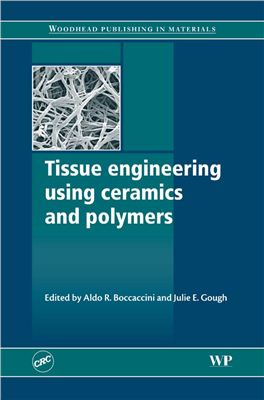Woodhead Publishing Ltd, 2007, 604 pages, ISBN: 1845691768
The field of tissue engineering has advanced dramatically in the last 10 years, offering the potential for regenerating almost every tissue and organ of the human body. Tissue engineering and the related discipline of regenerative medicine remain a flourishing area of research with potential new treatments for many more disease states. The advances involve researchers in a multitude of disciplines, including cell biology, biomaterials science, imaging and characterisation of surfaces and cell±material interactions. In the field of biomaterials, for example, many additional and novel processing techniques have been developed for the construction of improved porous scaffolds and matrices, including a much wider variety of polymers, ceramics and their composites with tailored micro- and nanostructure, surface topography and chemistry as well as optimised properties for the intended application in tissue engineering strategies. There are in fact many more materials being investigated for potential scaffolds, including novel uses of natural materials, combinations of natural and synthetic materials and new structures designed to mimic extracellular matrix at all relevant scales (macro, micro and nano), which are intended to provide scaffolds that are closer to the in vivo cellular environment. There is also strong emphasis on biomechanics and the effects of mechanical forces on the cell response and subsequent tissue formation, again, aiming to mimic the conditions in vivo.
General issues
Ceramic biomaterials
Polymeric biomaterials
Bioactive ceramics and glasses
Biodegradable and bioactive polymer/ceramic composite scaffolds
Transplantation of engineered cells and tissues
Surface modification to tailor the biological response
Combining tissue engineering and drug delivery
Carrier systems and biosensors for biomedical applications
Characterisation using X-ray photoelectron spectroscopy (XPS) and secondary ion mass spectrometry (SIMS)
Characterisation using environmental scanning electron microscopy (ESEM)
Characterisation of cells on tissue engineered construsts using imaging techniques/microscopy
Characterisation using Raman micro-spectroscopy
Tissue and organ generation
Engineering of tissues and organs
Bone regeneration and repair using tissue engineering
Bone tissue engineering and biomineralization
Cardiac tissue engineering
Intervertebral disc tissue engineering
Skin tissue engineering
Liver tissue engineering
Kidney tissue engineering
Bladder tissue engineering
Nerve bioengineering
Lung tissue engineering
Intestine tissue engineering
Micromechanics of hydroxyapatite-based biomaterials and tissue engineering scaffolds
Cartilage tissue engineering
The field of tissue engineering has advanced dramatically in the last 10 years, offering the potential for regenerating almost every tissue and organ of the human body. Tissue engineering and the related discipline of regenerative medicine remain a flourishing area of research with potential new treatments for many more disease states. The advances involve researchers in a multitude of disciplines, including cell biology, biomaterials science, imaging and characterisation of surfaces and cell±material interactions. In the field of biomaterials, for example, many additional and novel processing techniques have been developed for the construction of improved porous scaffolds and matrices, including a much wider variety of polymers, ceramics and their composites with tailored micro- and nanostructure, surface topography and chemistry as well as optimised properties for the intended application in tissue engineering strategies. There are in fact many more materials being investigated for potential scaffolds, including novel uses of natural materials, combinations of natural and synthetic materials and new structures designed to mimic extracellular matrix at all relevant scales (macro, micro and nano), which are intended to provide scaffolds that are closer to the in vivo cellular environment. There is also strong emphasis on biomechanics and the effects of mechanical forces on the cell response and subsequent tissue formation, again, aiming to mimic the conditions in vivo.
General issues
Ceramic biomaterials
Polymeric biomaterials
Bioactive ceramics and glasses
Biodegradable and bioactive polymer/ceramic composite scaffolds
Transplantation of engineered cells and tissues
Surface modification to tailor the biological response
Combining tissue engineering and drug delivery
Carrier systems and biosensors for biomedical applications
Characterisation using X-ray photoelectron spectroscopy (XPS) and secondary ion mass spectrometry (SIMS)
Characterisation using environmental scanning electron microscopy (ESEM)
Characterisation of cells on tissue engineered construsts using imaging techniques/microscopy
Characterisation using Raman micro-spectroscopy
Tissue and organ generation
Engineering of tissues and organs
Bone regeneration and repair using tissue engineering
Bone tissue engineering and biomineralization
Cardiac tissue engineering
Intervertebral disc tissue engineering
Skin tissue engineering
Liver tissue engineering
Kidney tissue engineering
Bladder tissue engineering
Nerve bioengineering
Lung tissue engineering
Intestine tissue engineering
Micromechanics of hydroxyapatite-based biomaterials and tissue engineering scaffolds
Cartilage tissue engineering

